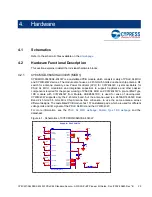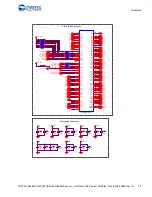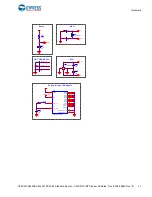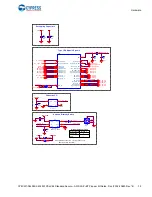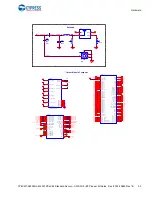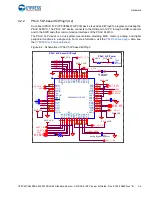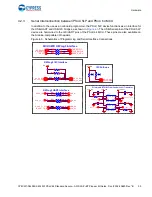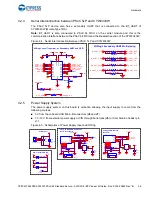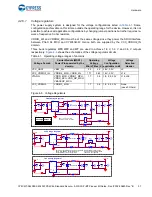
CY8CKIT-064S0S2-4343W PSoC 64 Standard Secure – AWS Wi-Fi BT Pioneer Kit Guide, Doc. # 002-30680 Rev. *B
22
Kit Operation
9.
External power supply VIN connector (J5):
This connector connects an external DC power
supply input to the onboard regulators.
10.
PSoC 64 MCU user buttons (SW2 and SW4):
These buttons can be used to provide an input to
PSoC 64 MCU. Note that by default these buttons connect the PSoC 64 MCU pin to ground
when pressed, so you need to configure the PSoC 64 MCU pin as a digital input with resistive
pull-up for detecting the button press. These buttons can also provide a wake-up source from
low-power modes of the device.
11.
Potentiometer connection jumper (J25):
This jumper connects the PSoC 64 MCU VDDA to
the potentiometer. Remove this jumper when measuring the PSoC 64 MCU power consumption.
12.
Potentiometer (R1):
This is a 10k Ohm potentiometer connected to PSoC 64 MCU pin P10[6]. It
can be used to simulate a sensor output to the PSoC 64 MCU.
13.
Arduino-compatible power header (J1):
This header powers the Arduino shields. It also has a
provision to power the kit though the VIN input.
14.
PSoC 64 MCU reset button (SW1):
This button is used to reset the PSoC 64 MCU. It connects
the PSoC 64 MCU reset (XRES) pin to ground.
15.
PSoC 64 MCU debug and trace header (J12):
This header can be connected to an Embedded
Trace Macrocell (ETM)-compatible programmer/debugger. This is not loaded by default.
16.
PSoC 64 MCU program and debug header (J11):
This 10-pin header allows you to program
and debug the PSoC 64 MCU using an external programmer such as
17.
Arduino Uno R3-compatible I/O headers (J2, J3, and J4):
These I/O headers bring out pins
from PSoC 64 MCU to interface with the Arduino shields. Some of these pins are multiplexed
with onboard peripherals and are not connected to PSoC 64 MCU by default. For detailed
information on how to rework the kit to access these pins, see
.
18.
CapSense slider (SLIDER) and buttons (BTN0 and BTN1):
The CapSense touch-sensing
slider and two buttons, all of which are capable of both self-capacitance (CSD) and mutual-
capacitance (CSX) operation, allow you to evaluate Cypress’ fourth-generation CapSense tech-
nology. The slider and buttons have a 1-mm acrylic overlay for smooth touch sensing.
19.
PSoC 64 MCU VDDIO2 current measurement jumper (J18):
An ammeter can be connected to
this jumper to measure the current consumed by the PSoC 64 MCU VDDIO2 power domain.
This jumper is not loaded by default on the board. Before populating the jumper for current
measurements, ensure that R94 is removed.
20.
CYW4343W VDDIO_WL current measurement jumper (J17):
An ammeter can be connected
to this jumper to measure the current consumed by the CYW4343W VDDIO power domain.
21.
Cypress serial NOR flash memory (S25FL512S, U3):
A S25FL512S NOR flash of 512-Mbit
capacity is connected to the Quad SPI interface of the PSoC 64 MCU. The NOR device can be
used for both data and code memory with execute-in-place (XIP) supports and encryption.
22.
Cypress PSoC 64 MCU with CYW4343W Carrier Module (CY8CMOD-064S0S2-4343W,
MOD1):
This kit is designed to highlight the features of the PSoC 64 MCU on the
CY8CMOD-064S0S2-4343W. For details, see
CY8CMOD-064S0S2-4343W (MOD1) on
.
23.
CYW4343W based Murata Type 1DX module:
The Type 1DX module is an ultra-small module
that includes 2.4 GHz and WLAN and Bluetooth functionality. Based on Cypress CYW4343W,
the module provides high-efficiency RF front end circuits. To ease Wi-Fi certification, the Type
1DX module complies with IEEE 802.11a/b/g/n and Bluetooth 5.1 plus EDR, Power Class 1 +
BLE.
24.
Wi-Fi/BT antenna:
This is the onboard antenna connected to the Wi-Fi and Bluetooth module.
25.
PSoC 64 MCU:
This kit is designed to highlight the features of the PSoC 64 MCU. For details on
PSoC 64 MCU pin mapping, refer to
.






















